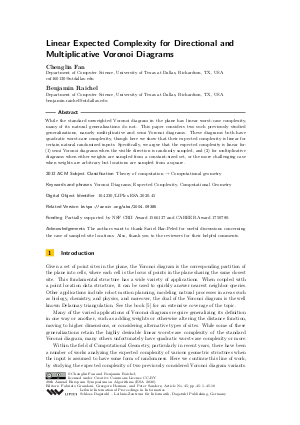Linear Expected Complexity for Directional and Multiplicative Voronoi Diagrams
Authors Chenglin Fan, Benjamin Raichel
-
Part of:
Volume:
28th Annual European Symposium on Algorithms (ESA 2020)
Part of: Series: Leibniz International Proceedings in Informatics (LIPIcs)
Part of: Conference: European Symposium on Algorithms (ESA) - License:
 Creative Commons Attribution 3.0 Unported license
Creative Commons Attribution 3.0 Unported license
- Publication Date: 2020-08-26
File

PDF
LIPIcs.ESA.2020.45.pdf
- Filesize: 0.61 MB
- 18 pages
Document Identifiers
Related Versions
Subject Classification
ACM Subject Classification
- Theory of computation → Computational geometry
Keywords
- Voronoi Diagrams
- Expected Complexity
- Computational Geometry
Metrics
- Access Statistics
-
Total Accesses (updated on a weekly basis)
0Document
0Metadata
Abstract
While the standard unweighted Voronoi diagram in the plane has linear worst-case complexity, many of its natural generalizations do not. This paper considers two such previously studied generalizations, namely multiplicative and semi Voronoi diagrams. These diagrams both have quadratic worst-case complexity, though here we show that their expected complexity is linear for certain natural randomized inputs. Specifically, we argue that the expected complexity is linear for: (1) semi Voronoi diagrams when the visible direction is randomly sampled, and (2) for multiplicative diagrams when either weights are sampled from a constant-sized set, or the more challenging case when weights are arbitrary but locations are sampled from a square.
Cite As Get BibTex
Chenglin Fan and Benjamin Raichel. Linear Expected Complexity for Directional and Multiplicative Voronoi Diagrams. In 28th Annual European Symposium on Algorithms (ESA 2020). Leibniz International Proceedings in Informatics (LIPIcs), Volume 173, pp. 45:1-45:18, Schloss Dagstuhl – Leibniz-Zentrum für Informatik (2020)
https://doi.org/10.4230/LIPIcs.ESA.2020.45
BibTex
@InProceedings{fan_et_al:LIPIcs.ESA.2020.45,
author = {Fan, Chenglin and Raichel, Benjamin},
title = {{Linear Expected Complexity for Directional and Multiplicative Voronoi Diagrams}},
booktitle = {28th Annual European Symposium on Algorithms (ESA 2020)},
pages = {45:1--45:18},
series = {Leibniz International Proceedings in Informatics (LIPIcs)},
ISBN = {978-3-95977-162-7},
ISSN = {1868-8969},
year = {2020},
volume = {173},
editor = {Grandoni, Fabrizio and Herman, Grzegorz and Sanders, Peter},
publisher = {Schloss Dagstuhl -- Leibniz-Zentrum f{\"u}r Informatik},
address = {Dagstuhl, Germany},
URL = {https://drops.dagstuhl.de/entities/document/10.4230/LIPIcs.ESA.2020.45},
URN = {urn:nbn:de:0030-drops-129111},
doi = {10.4230/LIPIcs.ESA.2020.45},
annote = {Keywords: Voronoi Diagrams, Expected Complexity, Computational Geometry}
}
Author Details
Funding
Partially supported by NSF CRII Award 1566137 and CAREER Award 1750780.
Acknowledgements
The authors want to thank Sariel Har-Peled for useful discussions concerning the case of sampled site locations. Also, thank you to the reviewers for their helpful comments.
References
-
Pankaj K. Agarwal, Sariel Har-Peled, Haim Kaplan, and Micha Sharir. Union of random Minkowski sums and network vulnerability analysis. Discrete & Computational Geometry, 52(3):551-582, 2014.

-
Boris Aronov, Mark de Berg, and Shripad Thite. The complexity of bisectors and Voronoi diagrams on realistic terrains. In Algorithms - ESA 2008, 16th Annual European Symposium, Karlsruhe, Germany, September 15-17, 2008. Proceedings, pages 100-111, 2008.

- Franz Aurenhammer. Power diagrams: Properties, algorithms and applications. SIAM J. Comput., 16(1):78-96, 1987. URL: https://doi.org/10.1137/0216006.
-
Franz Aurenhammer and Herbert Edelsbrunner. An optimal algorithm for constructing the weighted voronoi diagram in the plane. Pattern Recognition, 17(2):251-257, 1984.

-
Franz Aurenhammer, Rolf Klein, and Der-Tsai Lee. Voronoi Diagrams and Delaunay Triangulations. World Scientific, 2013.

-
Franz Aurenhammer, Bing Su, Yin-Feng Xu, and Binhai Zhu. A note on visibility-constrained Voronoi diagrams. Discrete Applied Mathematics, 174:52-56, 2014.

-
Marcin Bienkowski, Valentina Damerow, Friedhelm Meyer auf der Heide, and Christian Sohler. Average case complexity of Voronoi diagrams of n sites from the unit cube. In (Informal) Proceedings of the 21st European Workshop on Computational Geometry (EuroCG), pages 167-170, 2005.

- Timothy M. Chan and Konstantinos Tsakalidis. Optimal deterministic algorithms for 2-d and 3-d shallow cuttings. Discret. Comput. Geom., 56(4):866-881, 2016. URL: https://doi.org/10.1007/s00454-016-9784-4.
-
Hsien-Chih Chang, Sariel Har-Peled, and Benjamin Raichel. From proximity to utility: A Voronoi partition of Pareto optima. Discrete & Computational Geometry, 56(3):631-656, 2016.

-
Yongxi Cheng, Bo Li, and Yinfeng Xu. Semi Voronoi diagrams. In Computational Geometry, Graphs and Applications - 9th International Conference, CGGA 2010, Dalian, China, November 3-6, 2010, Revised Selected Papers, pages 19-26, 2010.

-
Anne Driemel, Sariel Har-Peled, and Benjamin Raichel. On the expected complexity of Voronoi diagrams on terrains. ACM Trans. Algorithms, 12(3):37:1-37:20, 2016.

- R. Dwyer. Higher-dimensional Voronoi diagrams in linear expected time. In Proc. 5th Annual Symposium on Computational Geometry (SOCG), pages 326-333, 1989. URL: https://doi.org/10.1145/73833.73869.
-
Chenglin Fan, Jun Luo, Wencheng Wang, and Binhai Zhu. Voronoi diagram with visual restriction. Theor. Comput. Sci., 532:31-39, 2014.

- Steven Fortune. A sweepline algorithm for voronoi diagrams. Algorithmica, 2:153-174, 1987. URL: https://doi.org/10.1007/BF01840357.
-
Jacob E. Goodman and Joseph O'Rourke, editors. Handbook of Discrete and Computational Geometry, Second Edition. Chapman and Hall/CRC, 2004.

- Sariel Har-Peled, Haim Kaplan, and Micha Sharir. Approximating the k-level in three-dimensional plane arrangements. In Proceedings of the Twenty-Seventh Annual ACM-SIAM Symposium on Discrete Algorithms (SODA), pages 1193-1212, 2016. URL: https://doi.org/10.1137/1.9781611974331.ch83.
-
Sariel Har-Peled and Benjamin Raichel. On the complexity of randomly weighted multiplicative Voronoi diagrams. Discrete & Computational Geometry, 53(3):547-568, 2015.

- D. T. Lee and Robert L. (Scot) Drysdale III. Generalization of voronoi diagrams in the plane. SIAM J. Comput., 10(1):73-87, 1981. URL: https://doi.org/10.1137/0210006.
- Micha Sharir. Intersection and closest-pair problems for a set of planar discs. SIAM J. Comput., 14(2):448-468, 1985. URL: https://doi.org/10.1137/0214034.
